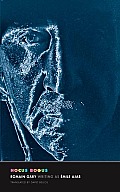Critical Mass regularly highlights exemplary reviews by our member critics. Here, in an essay recently published at the  Complete Review website, M.A. Orthofer discusses Émile Ajar's Hocus Bogus (Yale University Press).
Complete Review website, M.A. Orthofer discusses Émile Ajar's Hocus Bogus (Yale University Press).
Pseudo, finally available in English as Hocus Bogus, is one of the oddest works of (semi-)fiction of recent times. A documentary novel (of sorts), it came about because of the circumstances its author Romain Gary got himself into. Translator David Bellos recounts the whole bizarre story in his entertaining introduction to the book: basically, in 1974 Gary — a leading literary figure of the time — started writing books under the pseudonym of 'Emile Ajar' — and found too much success with them. When the first one was shortlisted for the Prix Renaudot he withdrew it, but then the next one was awarded the leading French literary prize, the Prix Goncourt in 1975 — a prize that is only awarded to an author once (and which Gary had already won). That prize-win drew a great deal of (unwanted) attention to the unknown author Ajar, whose identity Gary had managed to keep secret quite well until then. He got a cousin's son, Paul Pavlowitch, to play the part of Ajar, as it were, but journalists soon figured out the family connection, and there was speculation that Gary was the man behind the pseudonym. But, as he has his narrator say in this novel:
“I simply have to insist on not being identified,” I said. “It would make my life impossible.”
Hocus Bogus was the way Gary dealt with this mess he had gotten himself into, penning — in just a few weeks — what Bellos calls: “one of the most alarmingly effective mystifications in all literature”. As such, it was completely effective: “No one dared ever again to suggest that Romain Gary was Emile Ajar”.
What Gary did was offer a fictional spin on everything that had happened, a first-person account in which a mentally unhinged Pavlowitch-figure (spending most of his time in a Copenhagen psychiatric institution) describes his creative outpourings (and mental delusions). And the account comes complete with a Gary-like 'Uncle Bogey'-figure — a successful writer whose “prints are on everyone of man's misfortunes” (but who also pays for the narrator's institutional stay in Denmark), and who some suggest is behind the narrator's books ……
It's a fascinating novel that is both the wild story of (and by) a mentally unhinged artist, as well as a revealing book where, as Bellos notes: “Almost every sentence of the book is a double take”, its other meaning(s) only apparent once the true authorship (and circumstances) are known. There's the publisher who implores:
You have to stay in character, Ajar. […] You've got an aura and you have to keep it up. It's what we call news value. It's the best kind of advertising. You can't buy it, and it really sells books.
And one can hear Gary's own frustration with the monster he created in Ajar's complaint:
The less I tried to be the more I was. The more I hid the more I got covered by the media.
The schizophrenic narrator sounds perfectly convincing (“Since I knew I was fictional, I thought I might have a talent for fiction” he admits, in one of the many more-revealing-than-you-might-think passages), as Gary carefully writes (with very wild abandon) an account that makes the stories around the Ajar-books plausible. The whole scenario made sense, after all, if the author was the kind of person who took to exclaiming:
I was hugely relieved when on the appearance of my second book highly competent critics declared that Emile Ajar did not exist.
Hocus Bogus is quite incredible in how well it works as a double-layered text, as practically everything can be read two ways: (semi-)literally, like a 'normal' work of fiction, with Gary's confession (which is what it amounts to) the alternative-reading hidden underneath.
It's also a linguistic tour de force, as Gary revels in the possibilities his delusional character allows for; it's a challenge to the translator, and Bellos even writes that he first undertook the translation for his own amusement — “to see if it was even possible to simulate a rhetorical simulation of an imaginary psychological condition”. It is, necessarily, a very free translation (as the change in title already suggests), and Bellos acknowledges (and offers no apology for …):
any liberties I have taken with the text. I have larded it with my own bad puns. I have infiltrated anachronisms and literary allusions in some quantity, and I have exploited all the opportunities that English offered me to poke fun at police officers, politicians, publishers, psychiatry, surrealism, and good intentions.
It's a rare case where such liberties in translation are, indeed, welcome, and Bellos pulls the whole thing off with considerable aplomb, making for a weird, wild ride that certainly captures the spirit of the very strange original.
The Life and Death of Emile Ajar, Gary's posthumously-published account of the truth behind the Ajar-figure, is included in this volume, too — a helpful postscript closing this odd chapter. Not necessarily great literature, Hocus Bogus is a fascinating bit of literary history and a very interesting text (and translation). Good and very strange fun, and well worthwhile.


